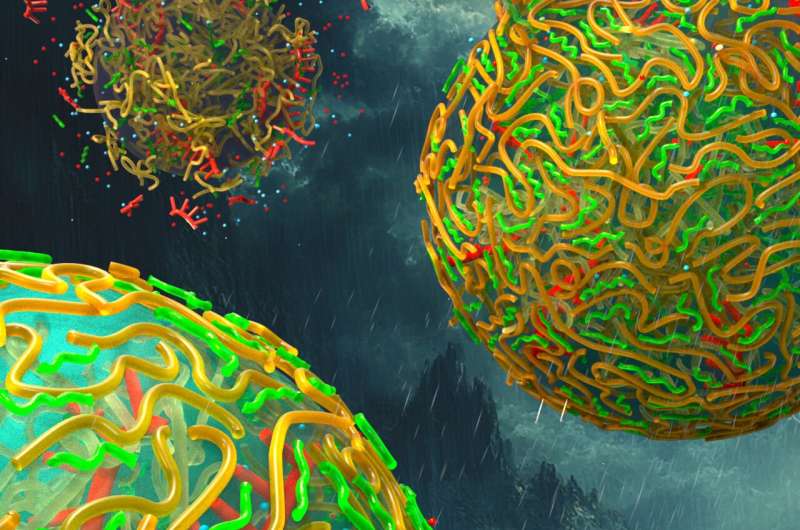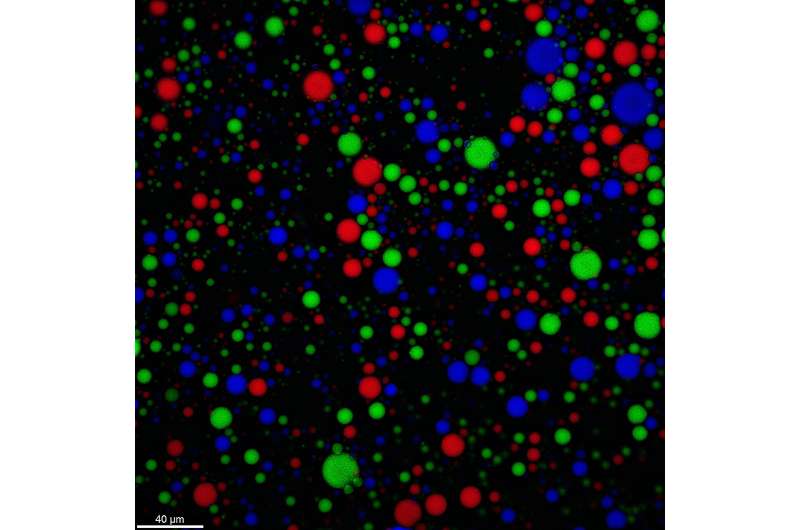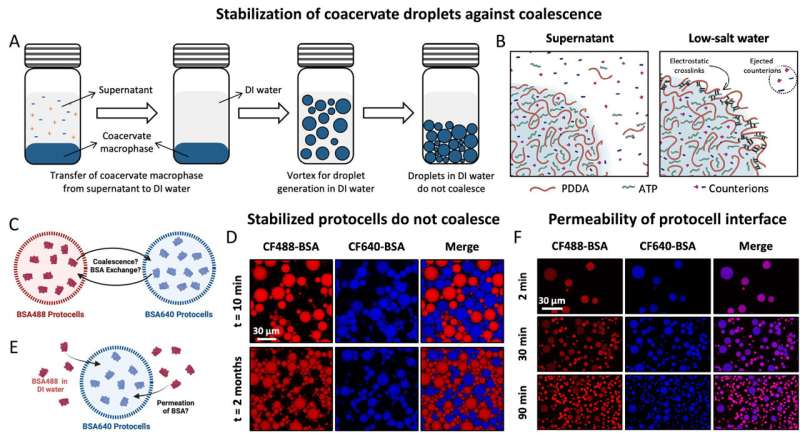This article has been reviewed according to Science X's editorial process and policies. Editors have highlighted the following attributes while ensuring the content's credibility:
fact-checked
peer-reviewed publication
trusted source
proofread
Life from a drop of rain: New research suggests rainwater helped form the first protocell walls

One of the major unanswered questions about the origin of life is how droplets of RNA floating around the primordial soup turned into the membrane-protected packets of life we call cells.
A new paper by engineers from the University of Chicago's Pritzker School of Molecular Engineering (UChicago PME), the University of Houston's Chemical Engineering Department, and biologists from the UChicago Chemistry Department, have proposed a solution.
In the paper, published in Science Advances, UChicago PME postdoctoral researcher Aman Agrawal and his co-authors—including UChicago PME Dean Emeritus Matthew Tirrell and Nobel Prize-winning biologist Jack Szostak—show how rainwater could have helped create a meshy wall around protocells 3.8 billion years ago, a critical step in the transition from tiny beads of RNA to every bacterium, plant, animal, and human that ever lived.
"This is a distinctive and novel observation," Tirrell said.
The research looks at "coacervate droplets"—naturally occurring compartments of complex molecules like proteins, lipids, and RNA. The droplets, which behave like drops of cooking oil in water, have long been eyed as a candidate for the first protocells. But there was a problem. It wasn't that these droplets couldn't exchange molecules between each other, a key step in evolution, the problem was that they did it too well, and too fast.
Any droplet containing a new, potentially useful pre-life mutation of RNA would exchange this RNA with the other RNA droplets within minutes, meaning they would quickly all be the same. There would be no differentiation and no competition—meaning no evolution.
And that means no life.
"If molecules continually exchange between droplets or between cells, then all the cells after a short while will look alike, and there will be no evolution because you are ending up with identical clones," Agrawal said.
Engineering a solution
Life is by nature interdisciplinary, so Szostak, the director of UChicago's Chicago Center for the Origins of Life, said it was natural to collaborate with both UChicago PME, UChicago's interdisciplinary school of molecular engineering, and the chemical engineering department at the University of Houston.
"Engineers have been studying the physical chemistry of these types of complexes—and polymer chemistry more generally—for a long time. It makes sense that there's expertise in the engineering school," Szostak said. "When we're looking at something like the origin of life, it's so complicated and there are so many parts that we need people to get involved who have any kind of relevant experience."
In the early 2000s, Szostak started looking at RNA as the first biological material to develop. It solved a problem that had long stymied researchers looking at DNA or proteins as the earliest molecules of life.

"It's like a chicken-egg problem. What came first?" Agrawal said. "DNA is the molecule which encodes information, but it cannot do any function. Proteins are the molecules which perform functions, but they don't encode any heritable information."
Researchers like Szostak theorized that RNA came first, "taking care of everything" in Agrawal's words, with proteins and DNA slowly evolving from it.
"RNA is a molecule which, like DNA, can encode information, but it also folds like proteins so that it can perform functions such as catalysis as well," Agrawal said.
RNA was a likely candidate for the first biological material. Coacervate droplets were likely candidates for the first protocells. Coacervate droplets containing early forms of RNA seemed a natural next step.
That is until Szostak poured cold water on this theory, publishing a paper in 2014 showing that RNA in coacervate droplets exchanged too rapidly.
"You can make all kinds of droplets of different types of coacervates, but they don't maintain their separate identity. They tend to exchange their RNA content too rapidly. That's been a long-standing problem," Szostak said.
"What we showed in this new paper is that you can overcome at least part of that problem by transferring these coacervate droplets into distilled water—for example, rainwater or freshwater of any type—and they get a sort of tough skin around the droplets that restricts them from exchanging RNA content."
'A spontaneous combustion of ideas'
Agrawal started transferring coacervate droplets into distilled water during his Ph.D. research at the University of Houston, studying their behavior under an electric field. At this point, the research had nothing to do with the origin of life, just studying the fascinating material from an engineering perspective.
"Engineers, particularly Chemical and Materials, have good knowledge of how to manipulate material properties such as interfacial tension, role of charged polymers, salt, pH control, etc.," said University of Houston Prof. Alamgir Karim, Agrawal's former thesis advisor and a senior co-author of the new paper. "These are all key aspects of the world popularly known as 'complex fluids'—think shampoo and liquid soap."
Agrawal wanted to study other fundamental properties of coacervates during his Ph.D. It wasn't Karim's area of study, but Karim had worked decades earlier at the University of Minnesota under one of the world's top experts—Tirrell, who later became founding dean of the UChicago Pritzker School of Molecular Engineering.
During a lunch with Agrawal and Karim, Tirrell brought up how the research into the effects of distilled water on coacervate droplets might relate to the origin of life on Earth. Tirrell asked where distilled water would have existed 3.8 billion years ago.
"I spontaneously said 'rainwater!' His eyes lit up and he was very excited at the suggestion," Karim said. "So, you can say it was a spontaneous combustion of ideas or ideation!"

Tirrell brought Agrawal's distilled water research to Szostak, who had recently joined the University of Chicago to lead what was then called the Origins of Life Initiative. He posed the same question he had asked Karim.
"I said to him, 'Where do you think distilled water could come from in a prebiotic world?'" Tirrell recalled. "And Jack said exactly what I hoped he would say, which was rain."
Working with RNA samples from Szostak, Agrawal found that transferring coacervate droplets into distilled water increased the time scale of RNA exchange—from mere minutes to several days. This was long enough for mutation, competition, and evolution.
"If you have protocell populations that are unstable, they will exchange their genetic material with each other and become clones. There is no possibility of Darwinian evolution," Agrawal said. "But if they stabilize against exchange so that they store their genetic information well enough, at least for several days, so that the mutations can happen in their genetic sequences, then a population can evolve."
Rain, checked
Initially, Agrawal experimented with deionized water, which is purified under lab conditions. "This prompted the reviewers of the journal who then asked what would happen if the prebiotic rainwater was very acidic," he said.
Commercial lab water is free from all contaminants, has no salt, and lives with a neutral pH perfectly balanced between base and acid. In short, it's about as far from real-world conditions as a material can get. They needed to work with a material more like actual rain.
What's more like rain than rain?
"We simply collected water from rain in Houston and tested the stability of our droplets in it, just to make sure what we are reporting is accurate," Agrawal said.
In tests with the actual rainwater and with lab water modified to mimic the acidity of rainwater, they found the same results. The meshy walls formed, creating the conditions that could have led to life.
The chemical composition of the rain falling over Houston in the 2020s is not the rain that would have fallen 750 million years after the Earth formed, and the same can be said for the model protocell system Agrawal tested.
The new paper proves that this approach of building a meshy wall around protocells is possible and can work together to compartmentalize the molecules of life, putting researchers closer than ever to finding the right set of chemical and environmental conditions that allow protocells to evolve.
"The molecules we used to build these protocells are just models until more suitable molecules can be found as substitutes," Agrawal said. "While the chemistry would be a little bit different, the physics will remain the same."
More information: Aman Agrawal et al, Did the exposure of coacervate droplets to rain make them the first stable protocells?, Science Advances (2024). DOI: 10.1126/sciadv.adn9657. www.science.org/doi/10.1126/sciadv.adn9657
Journal information: Science Advances
Provided by University of Chicago




















